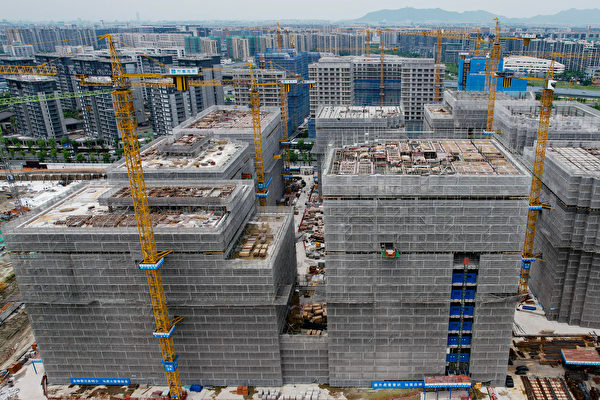In news released by the National Bureau of Statistics of the People’s Republic of China on September 14, it was reported that in August of this year, among the 70 major cities in China, prices of residential properties in various tier cities saw a month-on-month decrease, with a widening decline compared to the same period last year.
According to the data released by the National Bureau of Statistics on its official website on the 14th of September, the report titled “Changes in the Selling Prices of Residential Properties in 70 Major Cities in August 2024” was made public.
Comparing August to July of this year, the selling prices of new residential properties in first-tier cities (Beijing, Shanghai, Guangzhou, Shenzhen) saw a month-on-month decline of 0.3%, with the decrease in margin narrowing by 0.2 percentage points compared to the previous month. Among them, Beijing, Guangzhou, and Shenzhen each saw declines of 0.5%, 0.5%, and 0.8% respectively, while Shanghai saw an increase of 0.6%. Second and third-tier cities experienced declines of 0.7% and 0.8% respectively in the selling prices of new residential properties compared to the previous month, with the declines expanding by 0.1 percentage points.
In August, the selling prices of second-hand residential properties in first-tier cities experienced a month-on-month decrease of 0.9%, with the decline widening by 0.4 percentage points from the previous month. Specifically, Beijing, Shanghai, Guangzhou, and Shenzhen saw respective declines of 1.0%, 0.6%, 0.7%, and 1.3%. Second and third-tier cities also saw decreases in the selling prices of second-hand residential properties by 1.0% and 0.9% respectively compared to the previous month, with the declines expanding by 0.2% and 0.1% respectively.
Compared to the same period last year, the selling prices of new residential properties in first-tier cities in August saw a year-on-year decrease of 4.2%, with the decline remaining the same as the previous month. Notably, Beijing, Guangzhou, and Shenzhen saw declines of 3.6%, 10.1%, and 8.2% respectively, while Shanghai saw an increase of 4.9%. Second and third-tier cities had year-on-year decreases of 5.3% and 6.2% respectively in the selling prices of new residential properties, with the declines expanding by 0.5% and 0.4% compared to the previous month.
As for second-hand residential properties, the prices in first-tier cities saw a year-on-year decline of 9.4% in August, with the decline widening by 0.6 percentage points from the previous month. Beijing, Shanghai, Guangzhou, and Shenzhen experienced respective declines of 8.5%, 5.8%, 12.5%, and 10.8%. Similarly, second and third-tier cities witnessed decreases of 8.6% and 8.5% in the selling prices of second-hand residential properties compared to the same period last year, with the declines expanding by 0.4 percentage points.
On the whole, in August, the selling prices of residential properties in the various tier cities showed a general downward trend both on a monthly basis and as a year-on-year comparison.
Additionally, according to the report “Basic Situation of the National Real Estate Market from January to August 2024” released by the National Bureau of Statistics on the 14th, the total real estate development investment in the country amounted to 6.9284 trillion yuan, a 10.2% decrease compared to the same period last year. Of this, residential investment was 5.2627 trillion yuan, marking a 10.5% decline.
During the first eight months of the year, the construction area of residential properties by real estate development enterprises was 7.0942 billion square meters, a 12.0% decrease year-on-year, with the construction area for residential properties dropping by 12.6%. The area of new constructions saw a decline of 22.5%, with the area for new residential properties dropping by 23.0%. Completed construction area saw a decrease of 23.6%, with residential completions decreasing by 23.2%.
Moreover, data regarding the sales and inventory of new residential properties revealed that in the first eight months of the year, the sales area of new residential properties amounted to 606.02 million square meters, a decrease of 18.0% year-on-year, with the sales area for residential properties down 20.4%. The total sales value of new residential properties reached 597.23 billion yuan, a 23.6% dip, and the sales value for residential properties saw a decline of 25.0%.
By the end of August, the inventory of residential properties available for sale stood at 737.83 million square meters, indicating a 13.9% increase compared to the same period last year, with residential inventory showing a growth of 21.5%.
Furthermore, in the first eight months of the year, real estate development enterprises had a total of 6.9932 trillion yuan in funds in place, a decrease of 20.2% from last year. This included a 5.1% reduction in domestic loans, a 42.4% decline in the use of foreign funds amounting to 2 billion yuan, an 8.4% drop in self-raised funds, a 30.2% decrease in down payments and prepayments, and a 35.8% drop in individual mortgage loans amounting to 992 billion yuan.
The real estate market in mainland China continues to languish, prompting various levels of government from the central to local levels to introduce stimuli for the housing market, such as lifting restrictions on mortgages, purchase limitations, and qualifications, reducing loan interest rates, and offering cash subsidies to first-time home buyers, among other measures. However, these efforts to encourage home buying by the populace have not been effective.
According to data from the National Bureau of Statistics of the People’s Republic of China, the real estate price statistics of the 70 major cities are categorized into first, second, and third-tier cities as follows: First-tier cities include Beijing, Shanghai, Guangzhou, and Shenzhen; Second-tier cities include Tianjin, Shijiazhuang, Taiyuan, Hohhot, Shenyang, Dalian, Changchun, Harbin, Nanjing, Hangzhou, Ningbo, Hefei, Fuzhou, Xiamen, Nanchang, Jinan, Qingdao, Zhengzhou, Wuhan, Changsha, Nanning, Haikou, Chongqing, Chengdu, Guiyang, Kunming, Xi’an, Lanzhou, Xining, Yinchuan, and Urumqi; Third-tier cities consist of Tangshan, Qinhuangdao, Baotou, Dandong, Jinzhou, Jilin, Mudanjiang, Wuxi, Xuzhou, Yangzhou, Wenzhou, Jinhua, Bengbu, Anqing, Quanzhou, Jiujiang, Ganzhou, Yantai, Jining, Luoyang, Pingdingshan, Yichang, Xiangyang, Yueyang, Changde, Shaoguan, Zhanjiang, Huizhou, Guilin, Beihai, Sanya, Luzhou, Nanchong, Zunyi, and Dali.

